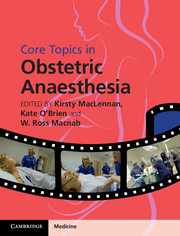Book contents
- Frontmatter
- Contents
- List of contributors
- Preface
- Section 1 Basic science, epidemiology and service organization
- 1 Physiology of pregnancy
- 2 Placental physiology
- 3 Pharmacology relevant to pregnancy
- 4 Maternal morbidity and mortality
- Section 2 Obstetric aspects
- Section 3 Provision of anaesthesia
- Section 4 Medical conditions in pregnancy
- Section 5 Postpartum complications and obstetric emergencies
- Section 6 Service organization
- Index
- Plate section
- References
1 - Physiology of pregnancy
from Section 1 - Basic science, epidemiology and service organization
Published online by Cambridge University Press: 05 December 2015
- Frontmatter
- Contents
- List of contributors
- Preface
- Section 1 Basic science, epidemiology and service organization
- 1 Physiology of pregnancy
- 2 Placental physiology
- 3 Pharmacology relevant to pregnancy
- 4 Maternal morbidity and mortality
- Section 2 Obstetric aspects
- Section 3 Provision of anaesthesia
- Section 4 Medical conditions in pregnancy
- Section 5 Postpartum complications and obstetric emergencies
- Section 6 Service organization
- Index
- Plate section
- References
Summary
Introduction
Maternal physiology undergoes complex changes during pregnancy in order to enable the female reproductive system to nurture and adapt to the fetus and placenta. The changes are predominantly either secondary to hormonal responses to female sex hormones or physical adaptations to increasing fetal size. The definition and detailed understanding of the normal physiological changes occurring in the antepartum, intrapartum and postpartum periods of pregnancy are crucial to recognize pathophysiological deviations as a result of disease and anaesthesia. Even though the changes are in fact quite widespread, this chapter will focus on some of the key physiological systems that are of direct relevance to the anaesthetist's management of a pregnant woman during the peripartum period.
Haematological system
Antepartum period
Pregnancy and the neonatal period result in significant changes in the haematological system with an associated increased risk for the development of complications, such as anaemia, thromboembolism and consumptive coagulopathies. Most haematological parameters are progressively altered during pregnancy and are reflected in laboratory investigations. Blood and plasma volumes increase, resulting in an adaptive hypervolaemia. An increase of 30–45% in the blood volume occurs, with changes starting at 6–8 weeks and peaking at 28–34 weeks, approximately 1.5 L higher than the prepregnant state. The increased blood volume is accompanied by increases in red cell mass secondary to increased erythropoiesis stimulated by high circulating levels of renal erythropoietin (Epo). The changes in erythropoiesis begin by week 10 and progressively accelerate through the second and third trimesters and are accompanied by erythroid hyperplasia of the bone marrow and an increase in the reticulocyte counts. While the early increases in erythropoietin may be due to the decreased oxygen-carrying capacity, in the last two trimesters, the increase is thought to be induced by progesterone, prolactin and human placental lactogen. Pregnancy-induced physiological changes are also responsible for a rise in red blood cell 2,3 diphosphoglycerate (2,3-DPG) levels leading to a gradual rightward shift of the maternal oxygen–haemoglobin dissociation curve, with improved oxygen transfer from mother to fetus. Red cell parameters like the mean corpuscular volume (MCV) and mean corpuscular haemoglobin concentration (MCHC) remain relatively stable in the absence of iron deficiency anaemia.
- Type
- Chapter
- Information
- Core Topics in Obstetric Anaesthesia , pp. 1 - 8Publisher: Cambridge University PressPrint publication year: 2015



